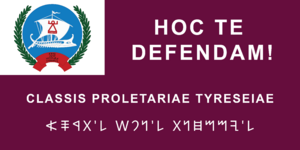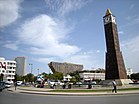User:Bigmoney/Sandbox
| Tyreseian Workers' Navy | |
|---|---|
| Classis Proletariae Tyreseiae 𐤋'𐤉𐤌𐤌𐤇𐤍𐤕 𐤋'𐤍𐤐𐤔 𐤋'𐤕𐤓𐤎𐤀 elYemamahanat elNapash elTuresaa | |
 Ensign of the Workers' Navy | |
| Motto | "Hoc te defendam" |
| Founded | 14 August 1848 |
| Current form | 1970 |
| Service branches | |
| Headquarters | New Tyria, Tyreseia |
| Leadership | |
| Chair of the Naval Command Council | Admiral Carthalo Barca |
| Director of National Defense | Meir Aroeste |
| Personnel | |
| Military age | 18 |
| Conscription | none |
| Active personnel | 205,000 |
| Expenditure | |
| Budget | $5.1 billion (2021) |
| Percent of GDP | 5% (2021) |
| Industry | |
| Foreign suppliers | Messidor Union Tsurushima |
The Tyreseian Workers' Navy, sometimes just the Workers' Navy or the People's Navy, is the regular military of the Workers' Federation of Tyreseia. It consists of the Tyreseian Workers' Naval Fleet, Tyreseian Workers' Naval Infantry Service, Tyreseian Workers' Naval Air Service, the Republican Guard and the Workers' Militias.
History
From the late Bronze Age through to the 2nd century BCE, the ancient Tyrian civilization utterly dominated the commercial and martime spheres of the Periclean world, with a navy that remained unmatched for most of its history. The navy, being the primary beneficiary of the Tyrian state, quickly overshadowed the ancient army, which was eventually abolished entirely and replaced with temporary mercenary clans hired by wealthy merchant houses. These same houses would then bring their armies to bear against one another, leading to a century of constant infighting that ended in a Latin conquest of the region. The Latin Empire brought with it a strong army tradition, but little naval experience, and so much of the region's naval development was put on hold until the Latins withdrew. From the 7th century CE to the 19th, the numerous states and statelets of the Tyreseian region maintained their own fighting forces with their own strategies, doctrines and tactics, only brought under one command again in 1861 following the Proclamation of National Unity. The Tyreseian Workers' Navy claims a lineage of history and tradition back in some parts to all of these fighting forces, such as through the traditional doctrine of maritime primacy inherited from the Tyrians and the use of vexilli from the Latins.
The modern history of a unified Tyreseian military began in the choas of the National Springtime, when the early fight for Tyreseian nationalism and unification was ironically carried out by numerous disjointed fighting forces. In 1848, the Tyreseian Republican Army (TRA) was raised in Oyat, the result of a coup that placed a pro-unification Consul in charge of the then-independent merchant city. The two militias that had placed the Consul in charge were merged into the TRA on October 14th, and thus became the direct ancestors to the Tyreseian Workers' Navy. The TRA quickly developed a maritime wing both through the existing Oyat fleet and through the seizure of a pirate haven in 1851, which bolstered their numbers considerably. Despite these successes, the conflict known as the First Unification War was still going poorly for the rebels; it would take an admiral from Tsabratan, XX XX, siezing control of the TRA and subsuming the infantry units under naval control. Such a forward-thinking strategy helped net the first major Tyreseian victory in the war at Gadam in February 1853. An army from Tyria was en route to attack a numerically inferior militia in the coastal town of Gadam. Utilizing his naval power, Admiral XX staged a night-time sneak attack on the Tyrian Royal Army, routing their forces and destroying their supply trains, forcing a rout. Such a surprise and sweeping victory led to the local militia and, eventually, the rest of the Tyreseian national military movement to consolidate under the Tyreseian Republican Navy's umbrella. The sudden consolidation of forces led to a lightning string of victories that ended the war in 1855, giving an unlikely victory for the rebels.
Branches
Ranks
The Tyreseian Workers' Navy branches are made up of numerous enlisted, non-commissioned officer, and commissioned officer ranks. A full table for each is included below.
Officer ranks
Enlisted and NCO ranks
Note: The red insignia depicted here are shoulder logos. The OR-1 red logo may be filled with the locality of the enlisted soldiers' militia if worn by a Workers' Militiaman.
Bactria
Kingdom of Bactria Βάχλο (Bactrian) | |
|---|---|
| Capital | Eucratideia |
| Religion | Manichaeism |
| Demonym(s) | Bactrian |
| Government | Unitary constitutional monarchy under a de facto military dictatorship |
• King | Antimachus IV Soter |
• President of His Majesty's Most Holy Council of Rule | General Diodotos Basileios |
| Legislature | Boule (unicameral) |
| Establishment | |
• Arrival of the Hellenes | 200s BCE |
| Currency | Bactrian drachma (BCD) |
| Time zone | UTC+7? (Western Ochran Time) |
| Date format | dd/mm/yyyy (CE) |
| Driving side | right |
| Internet TLD | .bc |
New Tyria
New Tyria
| |
|---|---|
| The City of New Tyria | |
|
Clockwise from top: New Tyria cityscape, Hall of Workers' Councils, Hanno's Square, The Latin Ampitheatre, National University of Tyreseia Wechsler Library | |
| Nicknames: The Big Olive, NTC, The 9s | |
| Country | |
| Region | Tyria |
| Council | Tyrian Metropolitan Area |
| Rebuilt | 180s BCE |
| Council Wards | 42 |
| Government | |
| • Mayor | Cachima Ezmac |
| • City Council | Tyria Multi-Municipal Council |
| Time zone | UTC+1 (Central Scipia Time) |
New Tyria is the capital and largest city in The Workers' Federation of Tyreseia.
Though the city lacks official legal status as the nation's capital city, New Tyria has nevertheless played an outsized role in Tyreseia's history, politics, and culture. Most of the nation's governmental institutions and unions are headquartered in the city, along with most foreign embassies and diplomatic missions. [DIPLOMATIC ORGANIZATION] is also headquartered in New Tyria.
National University of Tyreseia
Universitas Nationalis Tyreseiensis | |
Former names | Collegium Bibliothecae Tyriensis |
|---|---|
| Motto | Lux et veritas (Latin) |
Motto in English | Light and truth |
| Type | Public research university |
| Established | 1095 CE |
| Endowment | ₰4 billion (2020) |
| Chancellor | Azmelqart ben-Abibaal |
| Vice-Chancellor | Stephanus Papilius |
| Dean | Ahum ben-Scipis |
Academic staff | 2,555 |
| Students | 35,908 (2020) |
| Undergraduates | 27,604 (2020) |
| Postgraduates | 8,304 (2020) |
| Location | , |
| Campus | Urban |
| Colours | Tyrian purple |
 | |
The National University of Tyreseia (UNT) is a public research university in The Workers' Federation of Tyreseia. Founded in 1095 CE as the Collegium Bibliothecae Tyriensis, the UNT is not only the oldest institution of higher education in Tyreseia, but among the oldest in the world. Founded during the Coptic Golden Age as a center of both religious and scholarly learning, the Collegium became a fully secular institution funded by the merchant guilds of New Tyria in the 14th century. Over the centuries, the Collegium accumulated millennia worth of knowledge, and with only minor interruptions, preserved it uninterrupted. Following the restructuring of the region in the mid-19th century, the Collegium and its preserved works became the backbone of the new National University.
Today, the National University of Tyreseia possesses several sprawling campuses across New Tyria, the nation's capital city. With programs in STEM, the humanities, and the arts, UNT dominates tertiary education in the southern Periclean Basin. Numerous students from across the nation and around the world flock to study at the University, which offers courses taught in Latin, Tyrian, Anglic, Audonic, Hebrew, Tsurushimese, Tamaziɣt, Nahuatl, and other languages.
History
Academics
UNT offers numerous associate's, bachelor's, and graduate degrees in numerous fields. The constituent colleges offering these degrees include:







